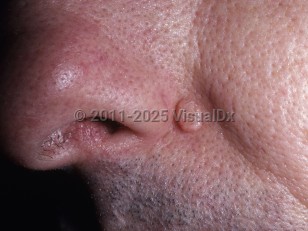Trichoepithelioma in Adult
Alerts and Notices
Important News & Links
Synopsis

Trichoepitheliomas are benign neoplasms derived from the hair follicles. They usually present as asymptomatic smooth, skin-colored papules or nodules on the central face and scalp.
Various genetic syndromes can be associated with trichoepitheliomas. Mutations in CYLD on chromosome 9 are inherited in an autosomal-dominant pattern and can result in 3 distinct clinical phenotypes: Brooke-Spiegler syndrome, multiple familial trichoepitheliomas, and familial cylindromatosis. Both Brooke-Spiegler syndrome and multiple familial trichoepitheliomas are associated with development of multiple trichoepitheliomas in childhood or early adolescence. Because of decreased penetrance of this gene in men, such trichoepitheliomas are more commonly seen in female patients.
Desmoplastic trichoepithelioma (DTE) is a variant of trichoepithelioma that presents on the face as a slow-growing, skin-colored papule or plaque with a raised border and depressed center. DTEs are most commonly seen on the cheeks of young women. Solitary, multiple, familial, and nonfamilial presentations have been described. Inheritance patterns, however, are not well elucidated.
Related topic: Cylindroma
Various genetic syndromes can be associated with trichoepitheliomas. Mutations in CYLD on chromosome 9 are inherited in an autosomal-dominant pattern and can result in 3 distinct clinical phenotypes: Brooke-Spiegler syndrome, multiple familial trichoepitheliomas, and familial cylindromatosis. Both Brooke-Spiegler syndrome and multiple familial trichoepitheliomas are associated with development of multiple trichoepitheliomas in childhood or early adolescence. Because of decreased penetrance of this gene in men, such trichoepitheliomas are more commonly seen in female patients.
Desmoplastic trichoepithelioma (DTE) is a variant of trichoepithelioma that presents on the face as a slow-growing, skin-colored papule or plaque with a raised border and depressed center. DTEs are most commonly seen on the cheeks of young women. Solitary, multiple, familial, and nonfamilial presentations have been described. Inheritance patterns, however, are not well elucidated.
Related topic: Cylindroma
Codes
ICD10CM:
D23.30 – Other benign neoplasm of skin of unspecified part of face
SNOMEDCT:
274898000 – Trichoepithelioma
D23.30 – Other benign neoplasm of skin of unspecified part of face
SNOMEDCT:
274898000 – Trichoepithelioma
Look For
Subscription Required
Diagnostic Pearls
Subscription Required
Differential Diagnosis & Pitfalls

To perform a comparison, select diagnoses from the classic differential
Subscription Required
Best Tests
Subscription Required
Management Pearls
Subscription Required
Therapy
Subscription Required
References
Subscription Required
Last Reviewed:10/14/2019
Last Updated:10/31/2019
Last Updated:10/31/2019
Trichoepithelioma in Adult

